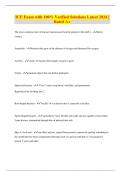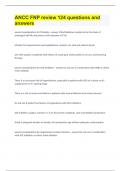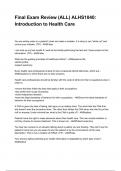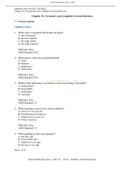And tick borne pathogens Study guides, Class notes & Summaries
Looking for the best study guides, study notes and summaries about And tick borne pathogens? On this page you'll find 47 study documents about And tick borne pathogens.
Page 2 out of 47 results
Sort by

-
ICE Exam with 100% Verified Solutions Latest 2024 | Rated A+
- Exam (elaborations) • 12 pages • 2024
-
- $7.99
- + learn more
The most common route of disease transmission from the patient to the staff is - direct contact Anaerobes - bacteria that grow in the absence of oxygen and destroyed by oxygen Areobes - variety of bacteria that require oxygen to grow fomite - inanimate object that can harbor pathogens Spherical bacteria - "Cocci" cause strep throat, tonsillitis, and pneumonia. Reproduced by dividing into 2 Rod-shaped bacteria - "bacilli" tb is a disease that is caused by a bacillus Spiral shaped bact...

-
ANCC FNP review |124 questions and answers
- Exam (elaborations) • 91 pages • 2023
- Available in package deal
-
- $13.99
- + learn more
special considerations for Thiazides Chlorthalidone is preferred on the basis of prolonged half-life and proven trial reduction of CVD. Monitor for hyponatremia and hypokalemia, monitor uric acid and calcium levels. Use with caution in patients with history of acute gout unless patient is on uric acid-lowering therapy. special considerations for ACE inhibitors Do not use in combination with ARBs or direct renin inhibitor. There is an increased risk of hyperkalemia, especially i...

-
WGU D236 pathophysiology Exam -Study Guide-With 100% verified answers-2022- 2023
- Exam (elaborations) • 26 pages • 2023
-
- $15.49
- + learn more
WGU D236 pathophysiology Exam -Study Guide-With 100% verified answers-2022- 2023 S - The study-notes marketplace S - The study-notes marketplace S - The study-notes marketplace WGU Pathophysiology D236 Describe how your body responds to an infection. T cells produce cytokines, which stimulate B cells. B cells produce antibodies. Identify role of DNA changes in congenital abnormalities. Mutations in genes or chromosomal abnormalities How does development disrupts congenital a...

-
Final Exam Review (ALL) ALHS1040: Introduction to Health Care
- Exam (elaborations) • 9 pages • 2024
-
- $11.39
- + learn more
Final Exam Review (ALL) ALHS1040: Introduction to Health Care You are writing notes in a patient's chart and make a mistake. It is okay to use "white out" and correct your mistake. (T/F) - ANSFalse I can look up my test results if I work at the facility performing the test and I have access to this information. (T/F) - ANSFalse What are the guiding principles of healthcare ethics? - ANSpreserve life uphold justice respect autonomy Every health care professional is likely...

-
WGU D236 pathophysiology Exam -Study Guide-With 100% verified answers-2022- 2023
- Exam (elaborations) • 26 pages • 2023
-
- $17.49
- + learn more
WGU D236 pathophysiology Exam -Study Guide-With 100% verified answers-2022- 2023 S - The study-notes marketplace S - The study-notes marketplace S - The study-notes marketplace WGU Pathophysiology D236 Describe how your body responds to an infection. T cells produce cytokines, which stimulate B cells. B cells produce antibodies. Identify role of DNA changes in congenital abnormalities. Mutations in genes or chromosomal abnormalities How does development disrupts congenital a...

-
AAMA - CMA Exam review - Infection Control
- Exam (elaborations) • 6 pages • 2022
-
- $13.49
- + learn more
The spread of disease is dependent on the _____ of __________ remaining unbroken. Answer- Chain Infection The goal of infection control is to stop the chain of infection from _________ the cycle to prevent disease. Answer- completing The first link of the chain of infection is the ______ _____. Answer- infective agent The infective agent can be a _____, _______, _____, _________ or __________. Answer- bacteria virus protozoa fungus rickettsia The second link of the chain of infection is ...

-
BIOLOGY 206 OpenStax Microbiology Test Bank Chapter 16: Disease and Epidemiology
- Exam (elaborations) • 17 pages • 2022
- Available in package deal
-
- $15.49
- + learn more
BIOLOGY 206 OpenStax Microbiology Test Bank Chapter 16: Disease and Epidemiology * = Correct answer Multiple Choice 1. Which term refers to the study of the geographic distribution of disease and its transmission? A. epidemiology* B. etiology C. morbidology D. pathology Difficulty: Easy ASM Standard: 23 2. Which term refers to the study of the cause of disease? A. epidemiology B. etiology* C. morbidology D. pathology Difficulty: Easy ASM Standard: 23 3. Tetanus, which is c...

-
OpenStax Microbiology Test Bank Chapter 25: Circulatory and Lymphatic System Infections Page 1 of 16 Chapter 25: Circulatory and Lymphatic System Infections * = Correct answer | 2022 latest update
- Exam (elaborations) • 16 pages • 2022
- Available in package deal
-
- $15.99
- + learn more
T E S T B A N K S E L L E R . C O M OpenStax Microbiology Test Bank Chapter 25: Circulatory and Lymphatic System Infections Page 1 of 16 Chapter 25: Circulatory and Lymphatic System Infections * = Correct answer Multiple Choice 1. Where does oxygenated blood enter the heart? A. the left atrium* B. the left ventricle C. the right atrium D. the right ventricle Difficulty: Easy ASM Standard: N/A 2. Which artery carries deoxygenated blood? A. aorta B. femoral C. pulmonary* D. subcl...

-
WGU D236 CORE EXAM Pathophysiology Q&A Rated A+
- Exam (elaborations) • 22 pages • 2023
-
- $10.99
- + learn more
WGU D236 CORE EXAM Pathophysiology Q&A Rated A+ Describe how your body responds to an infection. ANS- T cells produce cytokines, which stimulate B cells. B cells produce antibodies. Identify role of DNA changes in congenital abnormalities. ANS- Mutations in genes or chromosomal abnormalities How does development disrupts congenital abnormalities? ANS- Alterations of DNA Describes factors that disrupt homeostasis and how disruptions affect wellbeing. ANS- (ex) Fluid and electrolyte sh...

-
ICE Exam with 100% Verified Solutions Latest 2024 | Rated A+
- Exam (elaborations) • 12 pages • 2024
-
- $10.29
- + learn more
ICE Exam with 100% Verified Solutions Latest 2024 | Rated A+ The most common route of disease transmission from the patient to the staff is - direct contact Anaerobes - bacteria that grow in the absence of oxygen and destroyed by oxygen Areobes - variety of bacteria that require oxygen to grow fomite - inanimate object that can harbor pathogens Spherical bacteria - "Cocci" cause strep throat, tonsillitis, and pneumonia. Reproduced by dividing into 2 Rod-shaped bacteria - "bacilli...

Study stress? For sellers on Stuvia, these are actually golden times. KA-CHING! Earn from your study resources too and start uploading now. Discover all about earning on Stuvia


